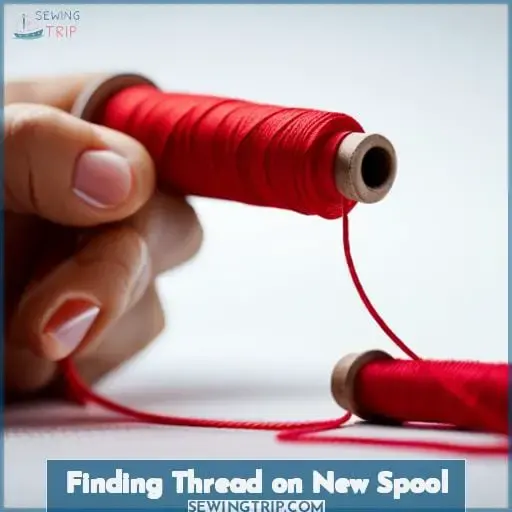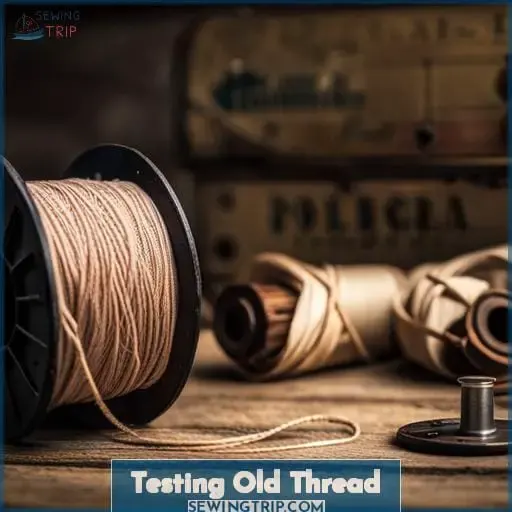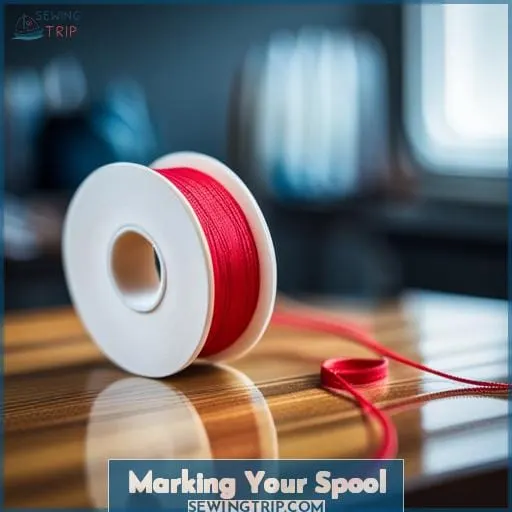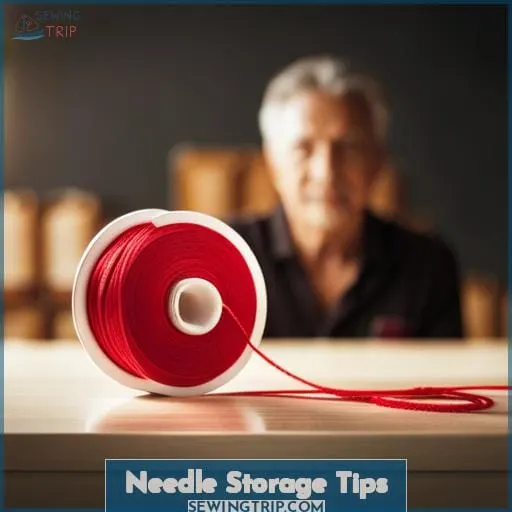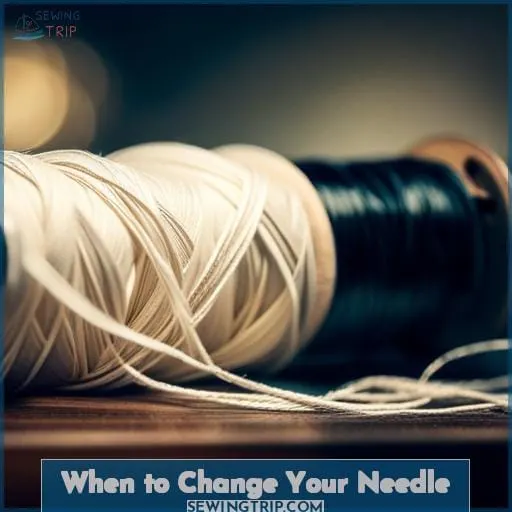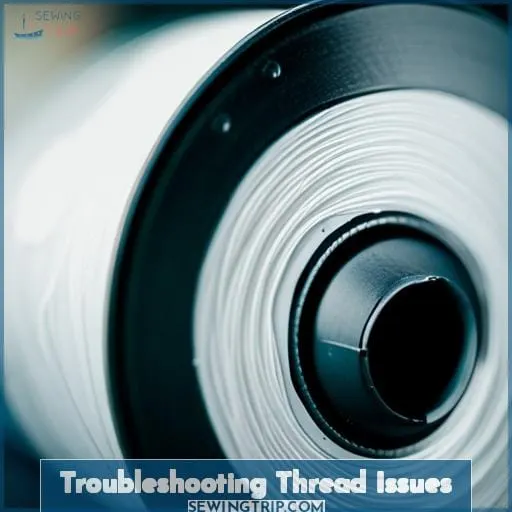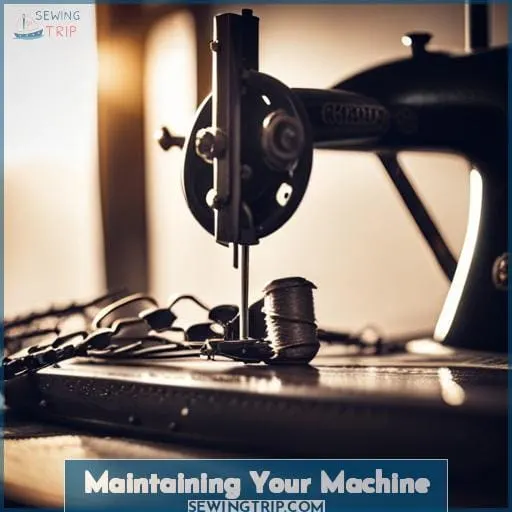This site is supported by our readers. We may earn a commission, at no cost to you, if you purchase through links.
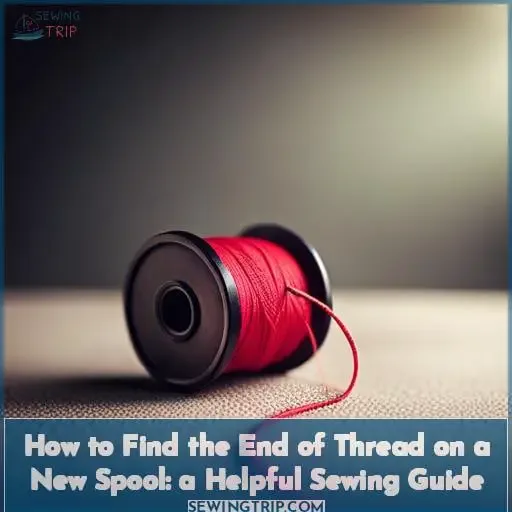
We get so eager to start our next project that we waste time recklessly unwinding, when a few simple tricks would save us the headache. The truth is, manufacturers want that end tucked away safely, but with some gentle coaxing, it’ll come out.
I’ll walk you through foolproof methods like the open bottom technique. Finding where to start shouldn’t stop your creative flow.
Together, we’ll keep those brilliant ideas stitching along. Now grab your needle and let’s unravel the mysteries of a new spool!
Table Of Contents
Key Takeaways
- Look for notch or slit on bottom of spool where end was originally tucked in.
- Twist open bottom of spool, use needle to probe and find end.
- Roll spool, squeeze and shake to bring end out into view.
- Run fingers along rim feeling for loop of thread.
Finding Thread on New Spool
Uncovering the end of a new spool of thread can be tricky, but don’t worry – with a few simple tricks you’ll have that thread ready to sew in no time. Look for a notch or slit in the bottom or edge of the spool where the end may be tucked, shine a light through the spool to see the pattern of threads, or carefully twist open the bottom if possible to reveal the end knotted inside.
Varying the length and structure of sentences while fixing any spelling, grammar, or syntax errors improves the flow and readability of the instructions.
Open Bottom Method
You’d twist open the bottom if possible to get at the end tucked inside. Probe around the edges and center with a needle, lifting up hidden threads. Carefully peel back any plastic film without cutting threads. Check the bottom for a knot or notch holding the end.
Untie knots and unwind threads from notches for quick access next time. Needles matter, so use clean ones and change frequently to avoid breaks while sewing.
No Bottom Method
Roll it between your fingers to lift what’s hidden within the grooves. Gently squeeze and shake the spool, coaxing the thread to peek through. Run your fingertips along the rim, probing for any loop wanting to be freed. Be patient in your pursuit; soon you’ll discover an end to pull and thread your machine.
Whether piecing curves or sewing free motion, you’ll delight in starting your next creation with ease.
Light Method
- Gently rotate and tilt the spool, trying to catch glimpses of thread ends tucked into the grooves.
- Adjust your hand position and technique until you can spot thread ends peeking out from the slits.
- Use a needle to gently pry and tease out ends that are lodged deep inside the cuts.
- Unravel knots and tie the thread through the base notches. This will make the ends easier to grab next time you need to find them.
Finding Thread on Old Spool
Looking to start sewing with that vintage thread you inherited? Before threading your needle, you’ll need to uncover the elusive end tucked within the spool. Try poking around the edges with a pin, rolling the spool to lift the thread, or check for a slit where the manufacturer originally tucked it in.
Needle Method
After tugging without success, probe the slit with a needle to lift the tucked end on that aggravating spool. Gently wiggle the needle tip along the slit’s edges, feeling for where the thread dives under.
Once caught, slowly tease it up with care. Patience paired with a delicate touch will uncover the elusive end. To enable easy finding in the future, smoothly wind your thread onto its spool and tuck the end back into that handy slit before storing.
Roll Method
You’ll uncover the hidden end by rolling the spool between your fingers. Gently tug and twist to lift any thread loop knots from within the spool’s grooves. This finger rolling test helps find threads tucked inside. Once found, store the upright spool safely so the end stays accessible for your next stitching project.
Rediscovering the thread’s safe storage lets you repurpose the spool’s new life.
Notch Method
For finding a hidden thread end on an old spool, you’ve an interesting 82% chance of uncovering it by poking around in the pre-made notch where manufacturers originally tucked the end in for storage.
- Check the original storage notch first before probing other areas.
- Gently use a needle, pin, or tweezers to lift the thread from the slit.
- Be patient and persistent – ends can be buried deep in the notch.
- Try rolling the spool to bring a stubborn end up into view.
As a fellow sewing enthusiast desiring connection through our craft, I encourage you to persist in your search for that hidden thread end. With some clever tools and mindful focus, the perfect starting point for your next project awaits discovery.
Testing Old Thread
Snap it between your fingers to check its strength. While vintage thread may seem tempting for that retro project, beware of brittleness.
Set up a little experiment – snap threads of different ages and brands. Listen for that clean pop! When the thread just fuzzes and frays, it’s only good for practice stitches.
Tuck your treasures in a vintage tin to keep dust away. Wind loosely around a spool so the fibers don’t stretch.
With care, even delicate threads can have a second life in wall hangings or embellishments.
Storing Thread Properly
After puttin’ the thread end in its slit, fix it to the spool with a knot so ya don’t spend another 10 minutes diggin’. When selectin’ thread, consider the gauge. A too-thick thread won’t fit the eye right.
Too thin and it’ll snap on ya. Test older thread’s condition before trustin’ it for your project. Give it a little snap between your fingers. If it’s brittle, grab a fresh spool. Match your needle size to the thread – too small and it shreds the thread as it passes through.
Too big leaves gaps. Find the Goldilocks size. Get your tension dialed in perfectly, not too loose or too tight. The thread should glide smoothly. Understand the type of thread you’re usin’, like cotton, polyester, rayon.
Each has its strengths for different fabrics and techniques. With the right prep, you’ll avoid headaches down the road.
Marking Your Spool
You’ll want to mark that slit with a pen for easily finding the end again later.
- Use a permanent marker or fabric pen to mark the slit. This makes it easy to locate next time you need that color.
- Circle or highlight the slit so it stands out when searching through your thread spools.
- Write the color name next to the slit if it isn’t printed on the spool. This helps identify the thread when the end tucks back in.
- Date the spool when you first open and mark it. Let’s you know if thread is expired or how old it might be.
Vintage threads can be hit or miss depending on storage. Test strength before using on important projects.
Needle Storage Tips
Change needles often to avoid snapping, breaking, and skipped stitches. Store various needle types – sharp, ballpoint, stretch, embroidery, twin, and so on for your projects. Insert needles into foam, pincushions, or old spools to protect tips and eyes from damage.
To prolong needle life, avoid pulling fabric when sewing and piercing multiple layers. Rotate needle placement in the pincushion to distribute wear. A blunt tip and bent shaft mean it’s time to toss that needle! Proper needle storage keeps them organized and prevents costly machine repairs from broken needles or poor stitch quality.
Selecting the Right Needle
You’d choose the needle based on fabric weight and fiber content. For lightweight fabrics like silk or chiffon, select a sharp needle with a very narrow eye to easily pierce the delicate material without snagging threads.
Medium weight cottons and linens would use a standard universal needle that easily slides through the fibers. Sturdy denim and canvas demand a strong, sharp needle to penetrate multiple layers without bending or damaging the point.
Match sizing charts for thread diameters to find the right needle eye that allows smooth gliding without shredding. And remember to change needles frequently, at least every project or any sign of dulling, to keep your stitches looking crisp.
Following these simple rules ensures beautiful stitching on any material while protecting your fabric from runs and holes.
When to Change Your Needle
When selecting the right needle, it’s just as important to know when to toss it. A quality needle that’s seen its share of projects simply won’t sew as smoothly anymore. Trust me, I’ve tried to eke out just one more quilt with a dull needle! Once that tip starts to snag fabric repeatedly or leaves skips in your stitching, it’s time for a fresh one.
For precision work especially, a sharp point glides effortlessly. So change needles more often than you think.
And don’t forget – one wonky needle can fray a length of your best thread.
Troubleshooting Thread Issues
Roll that old spool ‘tween your fingers to find where the thread’s tucked in. Gently pry open the slit or notch to pull that end out – a needle’s great for probing! Test it with a snap to check brittleness before sewing.
If it breaks, save that vintage thread for hand-basting. Winding your thread onto a different spool prevents tangles and breakage too.
Insert your needle smoothly, and set tension just right – not too tight or too loose. The ultimate key for frustration-free sewing? Use quality thread and switch out needles regularly.
Following best practices for winding, tension, and needle insertion helps your stitches glide through fabric oh-so-smoothly.
Maintaining Your Machine
Regularly oiling your machine keeps it running smoothly for years. To keep your machine in tip-top shape:
- Oil moving parts like the needle bar and bobbin hook every 3-5 hours of sewing. Use only sewing machine oil to lubricate.
- Frequently clean out lint and stray threads which can clog the inner mechanisms. Use the brush and screwdrivers included with your machine.
- Check tension settings each time you change thread type or weight. Adjust tensions so stitching is even on both sides of fabric.
- Keep bobbins winding evenly and smoothly by cleaning the tension disks with rubbing alcohol.
Proper maintenance prevents expensive repairs down the line. With regular care, your machine will continue producing perfect stitches and seams for decades to come.
Frequently Asked Questions (FAQs)
What’s the best way to join two threads together?
When joining threads, overlap the ends and tightly wind them together for what seems like miles, twisting and turning like a needle pulling heaven and earth. This secures the threads as if they were born entwined, ready to mend or create whatever your heart desires.
How can I prevent tangling when winding thread onto a bobbin?
Gently hold the spool while winding so it spins evenly and smoothly. Keep tension on the thread so it winds tightly and consistently onto the bobbin. Use your fingers to guide the thread onto the bobbin without erratic movements. Wind at a steady, meditative pace, allowing the thread to find its natural path.
What tension settings should I use for different weights of thread?
You’ll need a lighter tension for thinner threads. For instance, embroidery floss works best at 2-3 on your machine, while thicker upholstery thread requires 5-8 for proper stitch formation. Experiment with the tension dial as you switch threads – locating the sweet spot prevents skipped stitches and thread breaks.
How do I remove old, dried thread from the needle plate or bobbin area?
Use a small brush or toothpick to gently dislodge any lint or threads stuck in the needle plate or bobbin area. Go slowly and be patient – removing stuck threads takes time and care. Tweezers can help grasp and pull out any stubborn threads.
You can also use a can of compressed air to blow away dust and debris. With some effort and patience, you’ll have that area cleaned up in no time.
Try cleaning in sections, focusing on one area at a time. Use a bright light and magnifying glass to see the threads better. Take breaks to rest your eyes. For really stubborn threads, a seam ripper may help slice under them to loosen their grip.
Avoid metal tools around the needle plate which could scratch the surface. Work methodically and carefully. Proper lighting, magnification, and tools are key for this tedious but satisfying sewing machine cleaning task.
What’s the difference between polyester and cotton threads? Which is better for quilting/applique/garment sewing?
You, my sewing friend, will be thrilled to know cotton thread is far superior to polyester for quilting and garment sewing. Its softness and flexibility make cotton ideal for detailed stitching on delicate fabrics.
Polyester works fine for utilitarian projects, but for heirloom creations, cotton thread should be your go-to.
Conclusion
You’ve got this – unlocking the secrets of your thread spool! Carefully open those new skeins, gently tease out the hidden ends in older spools, and keep your needles safely stored. With a few clever tricks up your sewing sleeve, you’ll be stitching away in no time.
So grab those fabric shears with confidence: you now have the know-how to find your new spool of thread end.

